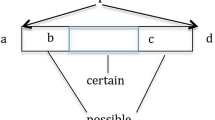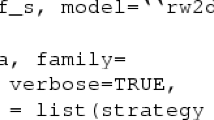Abstract
This paper describes the spatiotemporal epistematics knowledge synthesis and graphical user interface (SEKS–GUI) framework and its application in medical geography problems. Based on sound theoretical reasoning, the interactive software library of SEKS–GUI explores heterogeneous (spatially non-homogeneous and temporally non-stationary) health attribute distributions (disease incidence, mortality, human exposure, epidemic propagation etc.); expresses the health system’s dependence structure using (ordinary and generalized) spatiotemporal covariance models; synthesizes core knowledge bases, empirical evidence and multi-sourced system uncertainty; and generates a meaningful picture of the real-world system using space–time dependent probability functions and associated maps of health attributes. The implementation stages of the SEKS–GUI library are described in considerable detail using appropriate screens. The wide applicability of SEKS–GUI is demonstrated by reviewing a selection of real-world case studies.




















Similar content being viewed by others
References
Bogaert P (1996) Comparison of kriging techniques in a space–time context. Math Geol 28(1):73–86
Box GEP, Jenkins GM, Reinsel GC (1994) Time series analysis, forecasting and control, 3rd edn. Prentice Hall, Englewood Clifs
Choi K-M, Serre ML, Christakos G (2003) Efficient mapping of California mortality fields at different spatial scales. J Expo Anal Environ Epidemiol 13(2):120–133
Choi K-M, Christakos G, Wilson ML (2006) El Niño effects on influenza mortality risks in the state of California. J Public Health 120:505–516
Christakos G (1990) Random field modelling and its applications in stochastic data processing. Ph.D. Thesis, Division of Applied Sciences, Harvard University, Cambridge, MA
Christakos G (1991) On certain classes of spatiotemporal random fields with application to space–time data processing. IEEE Trans Syst Man Cybern 21(4):861–875
Christakos G (1992) Random field models in earth sciences. Acad Press, San Diego. New edition, Dover Publishing Inc., Mineola, NY, 2005
Christakos G (2000) Modern spatiotemporal geostatistics. Oxford University Press, New York
Christakos G, Bogaert P (1996) Spatiotemporal analysis of springwater ion processes derived from measurements at the Dyle Basin in Belgium. IEEE Trans Geosci Remote Sens 34(3):626–642
Christakos G, Hristopulos DT (1998) Spatiotemporal environmental health modelling. Kluwer, Boston
Christakos G, Kolovos A (1999) A study of the spatiotemporal health impacts of ozone exposure. J Expo Anal Environ Epidemiol 9(4):322–335
Christakos G, Lai J (1997) A study of the breast cancer dynamics in North Carolina. Soc Sci Med D Med Geogr 45(10):1503–1517
Christakos G, Bogaert P, Serre ML (2002) Temporal GIS. Springer, New York (with CD-ROM)
Christakos G, Kolovos A, Serre ML, Vukovich F (2004) Total ozone mapping by integrating data bases from remote sensing instruments and empirical models. Geosci Remote Sens 42(5):991–1008
Christakos G, Olea RA, Serre ML, Yu HL, Wang L-L (2005) Interdisciplinary public health reasoning and epidemic modelling: the case of black death. Springer, New York
Christakos G, Olea RA, Yu H-L (2007) Recent results on the spatiotemporal modelling and comparative analysis of Black Death and Bubonic Plague epidemics. J Public Health (in press)
Cressie N, Huang HC (1999) Classes of nonseparable, spatio-temporal stationary covariance functions. J Am Stat Assoc 94:1330–1340
Cromley EK, McLafferty SL (2002) GIS and public health. The Guilford Press, New York
Douaik A, Van Meirvenne M, Tóth T, Serre ML (2004) Space–time mapping of soil salinity using probabilistic Bayesian maximum entropy. Stoch Environ Res Risk Assess 18:219–227
Douaik A, Van Meirvenne M, Toth T (2005) Soil salinity mapping using spatio-temporal kriging and Bayesian maximum entropy with interval soft data. Geoderma 128:234–248
Ebi KL, Smith J, Burton I (2005) Integration of public health with adaptation to climate change. Taylor & Francis, Oxford
Gatrell AC (2002) Geographies of Health. Blackwell, Malden
Goodall C, Mardia KV (1994) Challenges in multivariate spatio-temporal modeling. In Proceedings of the XVIIth International Biometric Conference, 1–17, August 8–12, 1994, Hamilton, Ontario, Canada
Haas TC (1995) Local prediction of spatio-temporal process with an application to wet sulfate deposition. J Am Stat Assoc 90:1189–1199
Haggett P (2000) The geographical structure of epidemics. Clarendon Press, Oxford
Keil FC, Wilson RA (eds) (2000) Explanation and cognition. The MIT Press, Cambridge
Knorr Cetina K (1999) Epistemic cultures: how the sciences make knowledge. Harvard University Press, Cambridge
Kolovos A, Christakos G, Serre ML, Miller CT (2002) Computational BME solution of a stochastic advection-reaction equation in the light of site-specific information. Water Resour Res 38(12):1318–1334
Kolovos A, Christakos G, Hristopulos DT, Serre ML (2004) Methods for generating non-separable spatiotemporal covariance models with potential environmental applications. Adv Water Resour 27:815–830
Kolovos A, Yu H-L, Christakos G (2006) SEKS–GUI v.0.6 user manual. Department of Geography, San Diego State University, San Diego
Kyriakidis PC, Journel AG (1999) Geostatistical space–time models: a review. Math Geol 31(6):651–684
Law DCG, Bernstein K, Serre ML, Schumacher CM, Leone PA, Zenilman JM, Miller WC, Rompalo AM (2006) Modeling an early syphilis outbreak through space and time using the Bayesian maximum entropy approach. Ann Epidemiol 16(11):797–804
Ma C (2003) Spatio-temporal stationary covariance models. J Multivariate Anal 86:97–107
Meyer J-JCh, Van Der Hoek W (2004) Epistemic logic for AI and computer science. Cambridge University Press, Cambridge
Olea RA (1999) Geostatistics for engineers and earth scientists. Kluwer, Boston
Olea R (2006) A six-step practical approach to semivarogram modeling. J Stoch Environ Res Risk Assess 20(5):1436–3240
Orton TG, Lark RM (2007) Accounting for the uncertainty in the local mean in spatial prediction by BME. J Stoch Environ Res Risk Assess 21 (in press)
Quilfen Y, Chapron B, Collard F, Serre ML (2004) Calibration/validation of an altimeter wave period model and application to TOPEX/Poseidon and Jason-1 Altimeters. Marine Geodesy 27:535–550
Rescher N (2005) Epistemic logic: a survey of the logic of knowledge. University of Pittsburgh Press, Pittsburgh
Savelieva E, Demyanov V, Kanevski M, Serre ML, Christakos G (2005) BME-based uncertainty assessment of the Chernobyl fallout. Geoderma 128:312–324
Serre ML, Christakos G (1999) Modern geostatistics: computational BME in the light of uncertain physical knowledge—the Equus Beds study. Stoch Environ Res Risk Assess 13(1):1–26
Serre ML, Bogaert P, Christakos G (1998) Computational investigations of Bayesian maximum entropy spatiotemporal mapping. In: Buccianti A, Nardi G, Potenza R (eds) 4th Annual Conference, vol 1, De Frede Editore, Naples, Italy, pp 117–122
Serre ML, Kolovos A, Christakos G, Modis K (2003) An application of the holistochastic human exposure methodology to naturally occurring Arsenic in Bangladesh drinking water. Risk Anal 23(3):515–528
Stein ML (2005) Space–time covariance functions. J Am Stat Assoc 100:310–321
Wibrin M-A, Bogaert P, Fasbender D (2006) Combining categorical and continuous spatial information within the Bayesian maximum entropy paradigm. Stoch Environ Res Risk Assess 20:423–434
Yu H-L, Christakos G (2006) Spatiotemporal modelling and mapping of the bubonic plague epidemic in India. Int J Health Geogr, On-line Journal 5(12). http://www.ij-healthgeographics.com/content/5/1/12
Acknowledgments
The research was supported by grants from the Fred J. Hansen Institute (Grant No. 54266A P3590), the Oak Ridge National Lab (OR7865-001.01), and the National Institute of Environmental Health Sciences (P30ES10126).
Author information
Authors and Affiliations
Corresponding author
Additional information
An erratum to this article can be found at http://dx.doi.org/10.1007/s00477-007-0172-8
Appendices
Appendix A: The case of co-located data at Phase 2
Because duplicate coordinates (co-located data) may result in covariance matrix singularities, an initial check for duplicates is performed. The same adverse effect may occur at the prediction phase when geographical data are very close to each other. Co-location is not necessary associated with common public health problems in which a common geocode is assigned to participants with missing/incomplete addresses or to those residing in a specified geographic region to assure confidentiality. The interface defines the degree of proximity with respect to the geographical extent of the dataset and treats data that are too close to each other as co-located. Many methods may be used to alleviate the co-location issue, among them value averaging, slight spatial data displacement, and choosing a datum as the representative value of the co-located dataset. Another possibility is to merge co-located hard data into a unique soft data interval ranging within the span of the co-located hard data values. To preserve the character of the user’s dataset, the SEKS–GUI performs a simple averaging of the co-located hard data values and deals with co-location of soft uncertain data with other soft or hard data by means of slight random displacements.
Appendix B: Transformation options at Phase 2
By way of a summary, SEKS–GUI offers the following transformation options:
-
(a)
No transformation. The detrended dataset is left unaltered and the user proceeds to the prediction phase with the data in their original space.
-
(b)
N-scores transformation (also known as normal scores or Gaussian anamorphosis; Olea 1999). The detrended dataset is transformed to a N(0, 1) Gaussian distribution and the resulting dataset (used in space–time prediction) lies in the N-score space. Back-transformation to the original space is possible by using the N-score matrix. Since some extreme values may not back-transform properly using the N-score matrix, the SEKS–GUI sets upper and lower transformation limits that depend on the data span of the particular study, thus providing a means for extreme predictions to be appropriately back-transformed. All the N-score transformation functions are automatic and seamless to the user.
-
(c)
Box-Cox transformation (Box et al. 1994). The detrended dataset is tested with a series of power transformations based on a λ-parameter typically ranging within ± 2. The transformation eventually uses the λ-value bringing the data distribution closest to a Gaussian one. The resulting data values to be used in prediction are in the Box-Cox space. The back-transformation depends on the optimal λ-value chosen for the specific dataset. Note that the Box-Cox transformation is defined for positive data values only, while the detrended data will likely feature negative or zero values. If negative values are present, a constant is added to the detrended set so that all transformed values are positive. After being back-transformed to the original space, the constant is removed. The interface also accounts for the possibility of zero values (which pose problems when calculating logarithms). The above functions are performed automatically and are seamless to the user.
Appendix C: The BME and GBME techniques
Some of the implementation differences between BME and GBME are briefly discussed below (for more information about the two theories and technical details, the interested reader is referred to the relevant literature).
The two techniques may use different modelling assumptions and emphasize distinct core knowledge bases. For practical reasons, BME studies heterogeneity in an indirect way: it assumes a decomposition of the original attribute distribution into a mean function and a residual attribute, and a transformation operator is applied to the residual before BME is implemented. GBME theory deals directly with attribute heterogeneity in terms of space–time increments of the original distribution. Accordingly, the numerical implementation of GBME requires fewer steps than BME and its implementation is intrinsic, to a considerable extent. On the other hand, the BME steps are explicit, often allowing an increased participation of the user. GBME provides information about the space–time dependence structure in terms of the heterogeneity orders, which are not available in BME. GBME correlation analysis focuses on a local space–time scale at each prediction point, whereas BME analysis applies at a larger geographical scale that includes several prediction points. Accordingly, the GBME should perform best when enough data points are available at each local scale. On the other hand, there are more data points available at the BME scale, often generating smoother maps. While BME uses ordinary covariance functions that need to be positive-definite, GBME uses generalized covariance functions that need to be only conditionally positive-definite. Under certain conditions, the user may consider the implementation of a combination of BME and GBME, i.e., a decision is made to apply the BME technique in some sub-regions of the study area and the GBME technique in some others.
Rights and permissions
About this article
Cite this article
Yu, HL., Kolovos, A., Christakos, G. et al. Interactive spatiotemporal modelling of health systems: the SEKS–GUI framework. Stoch Environ Res Risk Assess 21, 555–572 (2007). https://doi.org/10.1007/s00477-007-0135-0
Published:
Issue Date:
DOI: https://doi.org/10.1007/s00477-007-0135-0




